
"Luck
Out"?
Having a Bad Aeromodelling Day? Why not compare notes with Gerard
Feeney
The phenomenon known as 'Murphy's' or 'Sod's Law' is a force to be reckoned with! While its effects are universal, the aeromodelling community feels its bitchy and perverse nature especially keenly. I'm sure that most people reading this could, in fact, write a book on their bizarre experiences! In the meantime, here are some selected 'Feeney Zone' high (low!) points from my own R/C archives. Who says that the Irish have all the good luck?!
Bad Vibes!
For a change, one was in a good mood. All the bills were paid, the weather was beautiful, and Westlife's latest single was topping the charts. Could it get any better? It seemed just the right time to visit the 'patch' to vent one's pent-up model flying emotions!
Once out in one's 'field of aeromodelling', circumstances flowed in an extremely pleasing manner. The engine roared into life almost on the first flick and, once tuned, it seemed eager to pull one's rather tatty 'Wotbox' towards the stratosphere! A solo launch soon put the model into its element, after just a dainty dash through the daisies. Surprisingly, although straight and level, the model was diving noticeably - time to haul back on the 'climb lever' to change its 'bad attitude', smartish!
What's this? Moving the elevator stick back met with severe resistance. In fact, there was no backward movement possible at all! Try again. Total stick jamming in the 'up elevator' department! With one eye on the rapidly descending model (one had throttled back a bit at this stage), and one eye on the transmitter, the reality dawned - bloody hell! The tranny neckstrap, which I wasn't using as intended, was wedged firmly right between the joystick base and the stick surround border flange housing! Any back-stick movement angled the strap 'chord-wise' between these two points, acting like a chair back wedged against a door handle.
Some extremely frantic fidgeting followed! The model had by this time, in fact, begun to climb up once more - just as well, because the strap untangling process seemed to take an eternity! What had started out as an enjoyable R/C flying session had soon degenerated into a 'knocking knees/Valium infusion' escapade. I just knew that it all was going too darn smoothly!
Murphy/Sod lesson number one: If your tranny has a neck-strap, either wear it as intended - or leave it off completely. Dangling bits of equipment (?) that are seldom used are just waiting to cause problems! Also, do check that all trim levers are at neutral before the launch/take-off.
Ground Force
Another idyllic day, another R/C model (a powered glider) circling peacefully at considerable height. One was beginning to relax (again!) as the model did some free-flight-style circuits gently downwind. At this point, I contemplated the notion of moving to a less hilly patch of ground. I chose to do this manoeuvre in 'reverse' mode, to keep the model in sight. I was about to 'fall' for my favourite hobby in a really big way…
Reversing steadily backwards, my world was suddenly turned upside-down - quite literally. Either I'd been mysteriously 'transported' into the cockpit of a manic 'Pitts Special', half way through an inverted spin, or I'd collided with something. Before I could even contemplate my sudden 'downfall', I was lying flat on my back amidst the picturesque rural flora. The glider's 'orientation' relative to my 'new' position had shifted uncomfortably so, naturally, I got back up again quickly to regain control - and to see wot tripped me up.
Yup, you guessed it! Murphy/Sod had ensured (probably by covert telepathic manipulation!) that I would reverse precisely into the only major hump of earth in that particular vicinity! Thank goodness there were no rocks protruding nearby, to split my skull open in the process. Next time, perhaps?
Murphy/Sod lesson number two: If planning 'cross-country' type flight antics, bring a mate along to guide your way. Or, survey the vicinity before launching a model at all, to check that your proposed pathway is clear of 'stumbling blocks'! At the very least, try not to step backwards for too great a distance whilst you are operating in 'solo flight' mode; if you go too far, that 'invisible trip-wire' will surely snare you!
Slapstick...
The latest R/C pupil was being tutored. His model was flying well - apparently stable and he seemed in control. I stepped briefly away to check my flight box. A split-second later, the novice flier's screams alerted me to the sight of his model rapidly descending in a full-power spiral death dive! The rookie pilot had 'frozen' on the sticks! I immediately adopted 'emergency alert status' - in other words, I ran at him and ripped the tranny from his 'vice-grip' grasp.
Such was the ferocity of that tranny 'changeover' manoeuvre that, as I knocked the guy sideways, and as I took hold of the controls, the right-hand joystick pole came away in my hand! All that remained to control the model was the now useless open-holed ball-joint stick base! On the left-hand stick, control was still possible - but the stick detachment fiasco stunned me so much I forgot all about it!
A surreal few seconds followed as model and ground became ever-closer friends! The novice stood stunned looking at me, whilst I stood there with my gob open - with the joystick lever in one hand and the tranny body in the other hand! The horrible sound of a full-throttle impact, and the shower of brightly-coloured debris, snapped us back into the cruel reality of what had just happened. The model was demolished almost totally - and we were both feeling 'shattered' as well!
I
can honestly say that this was (so far!) a one-off experience. The brand
of R/C gear is still widely available (it ain't Japanese, Taiwanese, or
German), so I guess ours was just a freak incident. (The new flier subsequently
gained his 'Wings' after repairing his model and tranny.)
Murphy/Sod lesson number three: Expect the unexpected always. Never ever
stray too far from a learner R/C pilot in the early stages - even if he/she
appears to be totally in control.
Some Like it Hot!!
How many of you high-flying websters have performed a 'sun manoeuvre'? In this scenario, despite all efforts made to do otherwise, one is guided in a semi-trance-like state to fly the model directly across the face of our nearest star with pinpoint accuracy. Now, in a semi-blinded condition, one struggles to regain control/orientation of one's model!
Beginners under tuition are especially prone to this occurrence, where all directions to "Avoid the ##££%%$$ sun!" are interpreted in reverse. However, the more experienced modellist is also 'blinded by the light of flight' on occasions. I should know - I've cried "Goodness gracious, great balls of fire!" often enough.
Murphy/Sod lesson number four: Try to remember: you are controlling the model, not the other way around - no matter what form of brainwashing is taking place in yer grey cell!
Getting Stoned
R/C model aircraft can be fragile things - especially when they have an 'argument' with hard, immovable objects; say a stone wall, for example. However, experienced fliers just don't get 'roughed up' in this manner too often. Wanna bet?
I was in a bad mood flying a sports model some time ago, due to excessively baulky engine runs. I didn't bother addressing the problem, I just tried to keep on flying. When the engine kept spluttering, I really lost my temper and I proceeded to enter a very hurried landing circuit. In reality, I actually entered a steeply diving turn from high up - with the engine coughing at idle all the way down. Here, the situation got tricky - the damn engine wouldn't cut either! Now, another factor entered the equation - the wind direction was coming across the field's 'narrow' dimension. This meant that I hadn't too much landing space to play with.
Before I realised, the speed build-up, due to that violently-executed approach pattern, carried the model almost fully across the width of the field. I was now heading quickly straight for the stone wall at the opposite end! At this point, I well and truly dithered. Should I keep trying to kill the revs? Should I throttle up and try going around again? Should I turn steeply to avoid the wall? Whilst contemplating these multiple-choice decisions, the wall solved the problem! By the time I'd decided to turn left, it was too late! The resulting 'sideways-on' banked impact against the wall top did a really great job of shattering the model's fuselage bottom and right wing underside. One was feeling well and truly - er - 'stoned' by the unexpected encounter! Another 'hard' aeromodelling lesson learned?
The model was subsequently repaired, and fitted with wings from another old unused design. It continued to perform well in this altered guise afterwards - once both the blocked carb jet and dodgy idle setting had been attended to. About one year later, the model finally met its ultimate demise in a full-power nose-first impact, due to a flat receiver nicad pack. That's the way the airframe crumbles!
Murphy/Sod lesson number five: Flying whilst in a foul mood, or otherwise preoccupied, is just asking for trouble. One's lack of concentration will surely be capitalised on - in the most negative and destructive way possible! Cool it, or you may make an already 'unstable' airborne situation even worse!
Prickly Heat
An impact with a hard stone wall would, naturally, cause profound damage to an R/C model aeroplane structure - but, even when far removed from nasty hard structures, out in one's pleasant long summer meadow, the most unlikely objects are also just waiting to pounce on one's model to break it!
Again, on this occasion, I was suffering from a troublesome engine run. In fact, I had the main needle valve set excessively rich to 'compensate' for cutting problems when I decided to give my model the old heave-ho. This was a definite mistake in the flat-calm and balmy mid-summer haze. With zero breeze to assist its climb, the model literally staggered and struggled to get away after release. It descended quickly and I anxiously did my 'gentle back-stick' routine to ease it skywards again.
In the couple of seconds it took to nurse it level, with the corrective pitch input, the (now about two-feet altitude) extended flare-out came perilously close to the long unwieldy meadow top. More worryingly, the model had veered straight for one of the huge, tall (about three-feet high!) macho thistles that littered the area. Guess wot happened next…?
Before I had time to cry "Hoots, mon!", the model's left wing struck the thistle shaft about halfway up its stalk. The aeroplane was immediately cartwheeled around its yawing plane to the left, and dumped unceremoniously in the long grass at the thistle base! No major damage ensued, except for a slight dent on the wing's left-hand leading edge - and, a decapitated thistle stalk! I wasn't so 'green' on the following flight(s), and a properly tuned engine (and de-blocked filter!) ensured high ascents above all that threatening foliage.
Murphy/Sod lesson number six: If oneself or one's model are in a vulnerable state, normally stable physical landmarks will 'move' to knock you for six while you're in the process of dithering!
Deadly Nightshade!
Barry Mulligan, from Ballyhaunis, Co. Mayo, called late one autumn evening to test-fly his latest micro-size R/C model. We chose to travel to a more distant, less familiar, flying site due to an access problem with the usual field. By the time we'd arrived at the new site and 'acclimatised' ourselves, a good half-hour had been whittled away. Another half-hour was spent in exasperation after that, trying to get the normally well-behaved small diesel engine to burst into life - and, to keep it singing for more than a minute at a time when it did go!
By the time that darn diesel was fairly reliably on-song, and after yet another round of 'pre-fright' checks, it was getting ominously dark as Barry handed me his tranny. Boy, were my hands ever shaking! Normally I'd refuse to do any R/C flying in such conditions, let alone do a test-fright with a tiny model, but I reckoned that the engine run would be short, going by our preceding experience…
The concept of Einstein's 'time dilation' theory, where the passage of time seems to change speed, was about to be taught to me. Usually, this phenomenon only happens near the speed of light - in this instance, my perception of time passage was changed in almost total darkness!
Warp Factor
For the best part of the following half-hour, the small PAW 80 diesel engine remained faithfully on-song! The midget-size airframe darted at near 'warp' speed through the increasingly concentrated dark blue murk as I sweated bullets! To add to the ordeal, Barry's model was badly out of trim and it was extremely sensitive to the rudder/elevator controls. Minus throttle control, a succession of knife-edge banked right-hand circular circuits had to be flown. Centre that rudder and the flaming plane would immediately bank violently left! To make matters even worse, maximum rudder trim had no effect - the main stick had to be held over all the time!
And still the ordeal continued. Visibility fell dramatically. I had to keep each erratic, permanently-banked, 'control-line' circuit almost directly overhead. One's knees knocked, one's eyes watered, one's neck became stiff. When in the blue blazes would the damn engine stop running?! I was tempted to dump the model in at full power!
Eventually 'golden silence' burst forth. The model was glided to safety more by feel and instinct than by precise visual orientation. It was now almost completely dark! It was lucky for Barry that Valium-flavoured carrots form a big part of my diet! I had always thought before this that lights on models were necessary for nocturnal flight - it sure seems that I was wrong!
Murphy/Sod lesson number seven: Don't fly throttle-less models of any size in the gathering dusk. The engine run will most probably exceed your concentration/sight levels with disastrous results.
Time's Up Sucker!!
All 'Feeney Fliers' are built in my small, pokey bedroom. Naturally, my modelling environment quickly degenerates into chaos, despite valiant efforts to keep it tidy. My long-suffering 'Nifty Nilfisk' makes frequent appearances to suck up the debris - but it's getting worn out. This fact was shown up during a recent clean-up job - the poor old hoover couldn't keep going. Obviously, the plug wiring had come loose with all the rough-and-tumble activity over the years. It was time to inspect wot was amiss.
Okay, check the wall plug end. Nothing apparently wrong - all the wires are held tightly in their terminal blocks. Time to wiggle the hoover body end with the machine going. Sure enough, the machine lurched 'twixt life and death. The fault lay inside this plug - I'd fix it after the dinner.
Two hours later. Right then, let's open up the offending plug. Time to check all that wiring! A tug of the exterior cord seemed to indicate a fractured connection in the positive terminal block. Better give it a wiggle closer to the terminal to make sure. Ouch! Got a bit of a nip/gash off the sharp-edged brass terminal block. The plug drops out of my hand - butter-fingers! I pick up the plug and start wiggling again. Here, I receive another unexpected sensation.
This time, as I'm fingering the terminals, I experience what feels like a mild burning sensation. "That's funny," I think, "How could the contacts be hot?" Then I drop the plug again; this time the cause is complete terror! The frightening reality of the situation had suddenly dawned on me - I'd been checking the exposed wires and plug terminal connectors, at the hoover body end, with the wall plug end still well and truly attached to the mains wall socket!!! I'd forgotten to unplug it after dinner!!!
To say that I was feeling 'shocked' was a major understatement! To think that I'd been happily and innocently fiddling about with bare fingers with the live wire, and getting mild shocks in the process, was just too mind-blowing to contemplate! Why wasn't I killed instantly? Was it the fact that I was sitting on my bed and wearing rubber-soled shoes that effectively insulated me against the potentially 'shocking' (fatal!) results? All I know for sure was that the actual shock/burn sensations were so mild that I never even suspected I was being zapped! For whatever reason I survived, I was jolly grateful - and woefully sobered! I've done some stupid things in my time, but this event really took the (toasted!) biscuit.
Ironically, I'm one of those obsessive people who are normally ultra-careful, to the point of paranoia, with electricity. I check all appliances and mains switches half-a-dozen times before hitting the hay - and I won't even touch an 'opened-up' appliance unless it's unplugged! Just that same week, I refused to repair a detached light bulb fitting, even with the mains current switched off at the junction box, until an electrician was summoned. Ironic, huh?
Murphy/Sod lesson number eight: You can be obsessively careful for 99.99% of the time, but 'M&S' will get you during that fraction of a second of distraction! In other words - be careful out (and in!) there.
Green and Pleasant Landings!
Finally, on extremely rare occasions, the potent force which decrees that: "Whatever can go wrong will go wrong!" can work in one's favour. Enjoy it while it lasts!
'Marvellous Michael' and myself were relishing a flying session in uncommonly pleasant weather conditions. Our models were performing well for several consecutive flights. Could the airborne bliss last? Of course not! Suddenly, the pleasing harmony of the two models' engines, singing in integrated unison, was shattered by what sounded like the raucous roar of an unsilenced motor vehicle. Then it dawned on us - one of our silencers had dropped off!
I was fairly sure that it wasn't mine (one is just too darn thorough to let such a thing happen!), so I did a low pass to confirm that all my 'bits' were still where they should be! They were! All the same, I quickly landed and Michael followed suit. Sure enough, his silencer had departed. He started combing the whole 'fallout' area; meanwhile, I went home (just across the road) to find a replacement silencer and retaining screws/bolts in my bits box.
As I dashed through the doorway, something caught my eye in the moss-infested weed patch that I like to call the front lawn. You could have knocked me over with a 'lupin'! There amongst my brightly-painted collector's edition Westlife figurines garden gnome set was Michael's missing muffler! I almost did cartwheels with excitement as I picked it up - it was totally undamaged! I then found some replacement silencer bolts in my spares box, and I dashed back to tell Michael the good news. He too was extremely pleased, to say the least.
We flew happily for the rest of the afternoon. Nothing else fell off, and we both came home feeling fulfilled and satisfied - for a change! At least, once in a while, things can work out for the best. However, on the next flying session…but that's another story!
Murphy/Sod lesson number nine: Remember, when it's all going wrong, you are an aeromodeller who is gaining something called 'experience'! When you've weathered countless setbacks, and come through it all much more philosophical and wiser than when you started, you may be called an 'expert' by your less experienced associates. They may now wish to know just why/how you possess that 'magic touch' - and why things always go 'smoothly' for you. The answer is that aeromodelling is a hard-learned craft, made to look easy by those who dare to persist in the face of much trial, error and tribulation. But, for the true aeromodeller, that very fact is why this wonderful hobby/sport has so much appeal!
From me, for now, toodle-pip!
Picture Captions
1-2: Beware the dangling transmitter strap! Either wear it around yer neck as intended - or leave it off altogether! Gerard really got 'hung up' in this area a while ago.
3-5: R/C models and hard stone walls - or other 'solid' landmarks - just don't mix! Ensure your airframe and engine/radio are all in top condition before launch - and, make a mental note of all the surrounding objects to avoid.
6-7: Tiny flying models and falling darkness are a real bad combination! Don't try operating R/C model aircraft of any size without throttle control in the late evening, unless you're prepared for the experience!
8: Make sure that your silencer is securely fastened - along with all your other important model bits - or you could become a 'dropout' like Gerard's flying friend…
 |
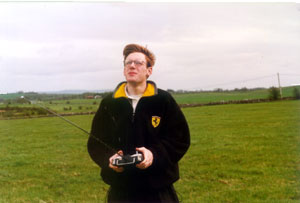 |
|
1
|
2
|
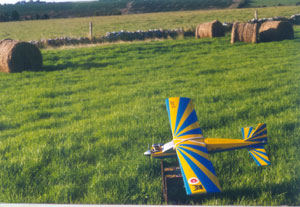 |
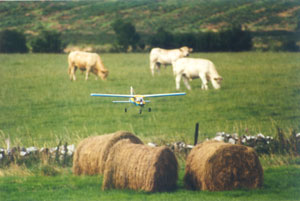 |
|
3
|
4
|
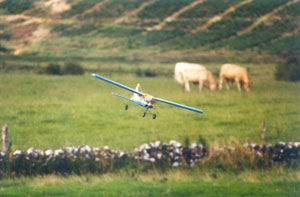 |
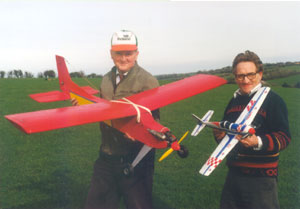 |
|
5
|
6
|
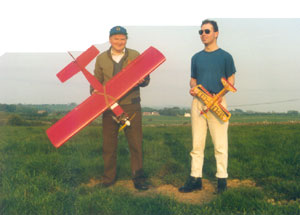 |
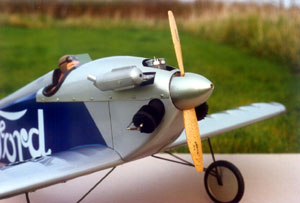 |
|
7
|
8
|